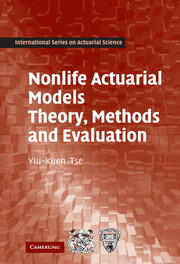Book contents
- Frontmatter
- Contents
- Preface
- Notation and convention
- Part I Loss models
- Part II Risk and ruin
- Part III Credibility
- Part IV Model construction and evaluation
- 10 Model estimation and types of data
- 11 Nonparametric model estimation
- 12 Parametric model estimation
- 13 Model evaluation and selection
- 14 Basic Monte Carlo methods
- 15 Applications of Monte Carlo methods
- Appendix: Review of statistics
- Answers to exercises
- References
- Index
11 - Nonparametric model estimation
from Part IV - Model construction and evaluation
Published online by Cambridge University Press: 05 June 2012
- Frontmatter
- Contents
- Preface
- Notation and convention
- Part I Loss models
- Part II Risk and ruin
- Part III Credibility
- Part IV Model construction and evaluation
- 10 Model estimation and types of data
- 11 Nonparametric model estimation
- 12 Parametric model estimation
- 13 Model evaluation and selection
- 14 Basic Monte Carlo methods
- 15 Applications of Monte Carlo methods
- Appendix: Review of statistics
- Answers to exercises
- References
- Index
Summary
The main focus of this chapter is the estimation of the distribution function and probability (density) function of duration and loss variables. The methods used depend on whether the data are for individual or grouped observations, and whether the observations are complete or incomplete.
For complete individual observations, the relative frequency distribution of the sample observations defines a discrete distribution called the empirical distribution. Moments and df of the true distribution can be estimated using the empirical distribution. Smoothing refinements can be applied to the empirical df to improve its performance. We also discuss kernel-based estimation methods for the estimation of the df and pdf.
When the sample observations are incomplete, with left truncation and/or right censoring, the Kaplan–Meier (product-limit) estimator and the Nelson–Aalen estimator can be used to estimate the survival function. These estimators compute the conditional survival probabilities using observations arranged in increasing order. They make use of the data set-up discussed in the last chapter, in particular the risk set at each observed data point. We also discuss the estimation of their variance, the Greenwood formula, and interval estimation.
For grouped data, smoothing techniques are used to estimate the moments, the quantiles, and the df. The Kaplan–Meier and Nelson–Aalen estimators can also be applied to grouped incomplete data.
Learning objectives
Empirical distribution
Moments and df of the empirical distribution
Kernel estimates of df and pdf
Kaplan–Meier (product-limit) estimator and Nelson–Aalen estimator
Greenwood formula
Estimation based on grouped observations
- Type
- Chapter
- Information
- Nonlife Actuarial ModelsTheory, Methods and Evaluation, pp. 301 - 334Publisher: Cambridge University PressPrint publication year: 2009

